Inside Vintage Electronic Toys – How Speak & Spell Works
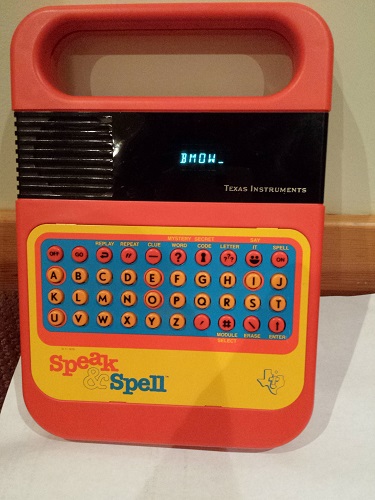
The 1970s were a great time to be a geeky kid, thanks to the introduction of the first digital electronic toys. With their beeping songs and blinking lights, who could resist them? Recently I decided to take a trip down memory lane, buying some classic 70s digital toys, and carefully disassembling them to reveal their vintage electronic guts. For about $50 and some time spent on eBay, I found myself the proud new owner of a Little Professor calculator, a Mattel Electronic Football handheld game, and the gem of the collection: a Speak & Spell talking toy.
Batteries
Today most portable electronics use a couple of AA or AAA batteries, but not these vintage devices. Little Professor and Football both need a 9V battery, and Speak & Spell actually uses four C cells. C cells?? I don’t think I’ve ever seen those used anywhere except flashlights and things with motors. The designers must have anticipated some major current demands that would have exhausted 9V or AA batteries too quickly.
The popularity of 9V batteries may have been because older semiconductor technologies often required higher voltages, like 9V or higher, compared to today’s chips that run at 5V, 3.3V, or even less. It’s also possible that classic devices relied on linear regulators to bring 9V down to the required 5V, but modern devices typically use boost regulators to bring 1.5V or 3V up to their required voltage.
Display
Another shared feature that caught my attention was the displays. None of the toys has an LCD display, and certainly not an LED display. In the mid-to-late 70s when these toys were made, LCDs were high tech and out of reach for cheap consumer devices. Instead of an LCD, Little Professor and Football both have red matrix LED displays, and Speak & Spell has a blue vacuum-fluorescent display that looks like something out of a sci-fi movie. Very retro!
Little Professor – Texas Instruments (1976)
The oldest of the bunch is Little Professor, first released by Texas Instruments in 1976. Over the years it went through many revisions, with different displays and buttons. The original version is shown here.
Little Professor is essentially a calculator in reverse: the display presents a math problem, such as 21 x 19, and the player must enter the answer. If the answer is correct, a new math problem is presented. An incorrect answer flashes EEE on the display. There are no sound effects, and no feedback of any kind beyond the numeric display. It’s drill-and-practice at its dullest, yet TI managed to sell over 1 million units in 1977.
Peeking inside reveals very few parts, and the contents are mostly empty air. There’s a membrane keyboard, LED matrix display, two slide switches for on/off and difficulty selection, and a single 28-pin SDIP (shrunken dip). That’s it. There’s not a single resistor or other passive component anywhere.
The secret to the low part count is that chip: a TMS0975 microcontroller. It’s a member of TI’s TMS1000 family, and a sibling of the TMS0972. These microcontrollers were widely used in other “real” calculators of the same period. They were 4 bit architectures, with three data registers, 1KB of ROM, and 32 bytes of RAM. The nominal clock speed was only 400 kHz. Unlike today’s microcontrollers, the ROM store was not re-writable, so once a program was stored in the MCU it was fixed forever.
Beyond the microcontroller functions, the TMS0975 also incorporated the LED digit drivers, keypad input, clock oscillator, and other elements. No external passive components were required. This would have helped keep manufacturing costs low. TI probably made a nice profit selling these at $20 apiece – that’s $82 in 2013 dollars!
Mattel Electronic Football – Mattel (1977)
Electronic Football was one of the first releases in Mattel’s long-running handheld sports series. And to be clear, we’re talking about American football here, not soccer. Two players take turns running offense, while the computer handles defense. The goal is to maneuver the bright red blip (the running back) through the dark red blips (the defenders) without being tackled.
Bright and dim red blips? It’s hard to imagine how this game could have been successful. Released in the summer of 1977 and sold through Sears, Electronic Football sold poorly at first. Sears used a computer model based on initial sales data to conclude the game wouldn’t be a major seller, and manufacturing was halted after fewer than 100K units were made. Then in mid-January 1978, Sears told Mattel they’d made a mistake, and that they wanted 200K units a week. By mid-February 1978, manufacturing reached the previously unknown level of 500K units per week. 500,000 Electronic Football toys shipped to Sears stores, every week! Wow.
This is Screwy
Getting inside the toy’s case was challenging. It’s held together with three security screws, requiring some kind of triangular screwdriver that doesn’t seem to exist anywhere, even in specialized bit sets. Really Mattel? Why? Their game was rather famously cloned by Coleco as “Electronic Quarterback”, so maybe this was Mattel’s attempt at preventing people from peeking under the covers and stealing the design, but it’s hard to imagine how security screws would have prevented corporate IP theft.
I searched the web to see if anyone else had a solution for the triangular screws. One person claimed they could be removed with a flat blade screwdriver, inserted just so, but nobody else was able to duplicate this feat. Certainly it didn’t work for me. Other discussions centered on making a custom screwdriver blade. In desperation I went rummaging through my toolbox, and discovered a three-sided file whose pointed end was exactly the right shape and size to fit the screws. Hooray!
Mattel’s Secrets Revealed
Once opened, the Electronic Football case revealed a single low-density board with the Rockwell International logo, and an attached speaker. By carefully removing the board and turning it over, I exposed Mattel’s hidden secrets. As with the Little Professor, there were surprisingly few components inside: just a membrane keyboard, an LED display, a slide switch, a resistor and a capacitor, and one mystery chip. The LED display was an interesting affair, with a calculator-style 7 segment display matrix in one half, and a 9 x 3 LED “football field” in the other.
Unfortunately the mystery chip was obscured by the keyboard, which was soldered in place, and I didn’t want to do anything destructive to gain better access to it. According to information I later found on the web, it’s a Rockwell B6100-15, which is a modified calculator chip not unlike the brains of the Little Professor. Further details were revealed in this interview with Mark Lesser, the Rockwell engineer who designed the circuitry and wrote the software for Electronic Football. Development was challenging, as the chip only had 512 bytes of program memory, and the assembler ran on a mainframe computer at Rockwell. The program was entered as a batch job using IBM computer punch cards.
I never found a satisfactory explanation for how the playfield blips were switched between dim and high brightness, providing three possible states for each blip: off, dim, or bright. This implies a changing voltage across the LED, but the LEDs were driven directly by the Rockwell chip, which presumably had digital outputs with only two states.
Speak & Spell – Texas Instruments (1978)
Texas Instruments released Speak & Spell in 1978. Looking back on it 35 years later, it’s hard now to appreciate just what a huge sensation it was. It talked! While today every phone and camera seems to have voice features, in 1978 this was unheard of. Some earlier toys like Chatty Cathy managed a few phrases of pre-recorded speech stored on tape or miniature phonograph discs, but nothing matched the verbosity or sophistication of Speak & Spell.
When E.T. used a Speak & Spell to phone home in 1982 (along with an umbrella, a circular saw, and some other junk), its lasting popularity was ensured. It became an international success, released as La Dictée Magique in France, Grillo Parlante in Spain and Latin America, and Buddy in Germany. Speak & Spell eventually went through many revisions, switching to an LCD display and a different keyboard, among other changes. The original 1978 version with blue vacuum fluorescent display is shown here.
The premise of Speak & Spell was simple. A synthesized voice would prompt the player for something like “spell ocean”. After dutifully typing O-C-E-A-N, the player would hear “that is correct”, followed by another word. A mistake would result in hearing “wrong” or “that is incorrect”. There were just enough alternative phrasings for correct/incorrect words to keep it from becoming repetitive, and the total spelling vocabulary was about 200 words. Expansion modules placed in the battery compartment could add a new vocabulary of an additional 200 words.
Under the Hood
As expected, the guts of Speak & Spell proved to be substantially more complex than either Little Professor or Electronic Football. After removing the back cover, I found a medium-size board connected to a speaker, with an expansion module attached. Hidden underneath were two membrane keyboards, one for each half of the button array on the front panel.
Removing the circuit board was more difficult than it first appeared. It was attached to the keyboards with stiff copper wires, and the keyboards were held on the front cover by plastic clips. Gentle prying on the plastic clips failed to release the keyboards, and more robust prying broke off two of the clips. $@&*#! After a lot of patient poking and wiggling and bending, I was finally able to remove the circuit board and keyboards, and flip them over to reveal the heart of the beast.
The brown board at top-left of the photo is the power board. It turned out to be a miniature switch-mode power supply, tucked inside the Speak & Spell! The rest of the goodies are on the green logic board, including the eight-character VFD display, and four custom TI chips. This is where all the magic happened.
Closest to the display is the 40 pin TMC0271 microcontroller, another member of the TMS1000 family. This 4 bit MCU had 2KB of program ROM, and 128 nibbles of RAM. Each instruction took six clock cycles to execute, at nominal clock speed of 320 kHz, for total throughput of 0.05 MIPS. It wasn’t blazing speed, but it got the job done.
At left and below the MCU is the 28 pin TMC0281, which was TI’s new single-chip voice synthesizer. More about this in a minute.
Below the MCU to the right, there are two ROM chips labeled TMC0351 and TMC0352. These 16KB ROMs were the largest available at the time, and were used to store speech data. Another 16KB ROM was discovered inside the expansion module when I cracked it open – this one labeled TMC0350. These ROMs didn’t have standard parallel or serial interfaces, but were strange designs containing an address counter and control circuitry in addition to the memory. By tracing the circuit board, other hackers have learned that the ROMs don’t interface to the microcontroller at all, but are driven directly by the speech synthesizer. Maybe that explains their strangeness.
Making it Talk
So how did Speak & Spell create human-sounding speech? It represented words as a series of phonemes, each one 25 milliseconds long. Each phoneme was generated by seeding the voice synthesizer with appropriate data. The synthesizer contained two audio oscillators. A periodic “chirp” oscillator produced a sound like a man saying “uhhhhh”, and was used to create voiced phonemes like the letter “O”. A separate noise oscillator was used to create unvoiced phonemes, like the letters “T” or “S”.
By controlling the volume and pitch of the oscillators, and further tuning their sounds by using a 10th order digital filter, a wide variety of speech-like sounds were possible. Encoded speech was very compact, requiring at most 12 numbers per phoneme: volume, pitch, and the 10 filter coefficients. By using repeat flags and omitting filter coefficients in some circumstances, the data was reduced still further. The average bitrate of speech encoded this way was about 1000 bps (125 bytes/sec). Thus the 16KB ROMs each provided space for about two minutes of encoded speech. Many more details on the synthesizer and the encoding mechanism can be found at furrtek.org.
In theory, it was possible to create synthetic speech by sitting in a quiet room and authoring synthesizer coefficients by hand until the desired sound was achieved, but this approach was incredibly time-consuming. Instead, Texas Instruments used a mainframe computer to analyze recordings of real human speech, and map them to the closest synthetic phoneme for each 25 ms interval. A radio DJ from the Dallas area was chosen as “the voice of Speak & Spell”, because his monotone delivery and deep voice could be efficiently encoded.
Speak & Spell was a fascinating product, with many more interesting details than I’ve described here. For more, check out this great technical article by one of Speak & Spell’s original designers at cnx.org.
Read 3 comments and join the conversation
3 Comments so far
Leave a reply. For customer support issues, please use the Customer Support link instead of writing comments.


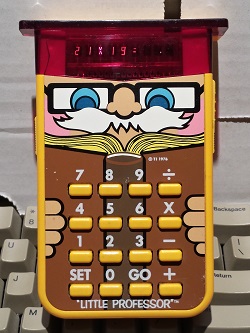
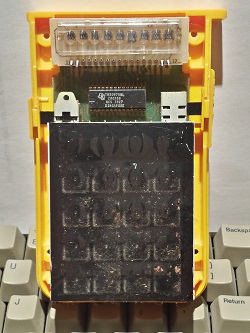
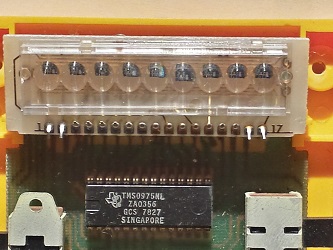
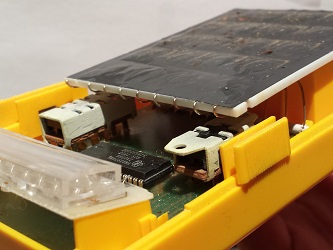
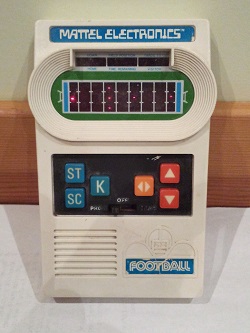
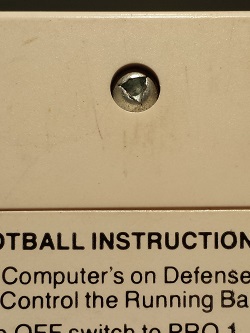
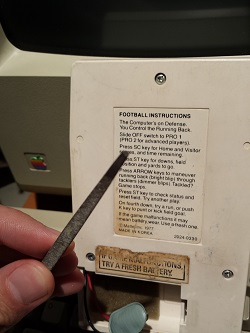
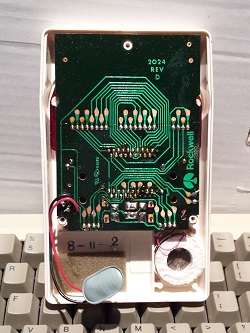
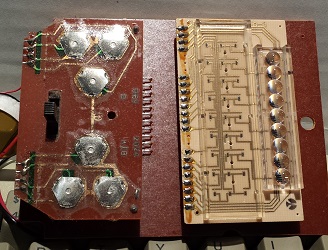
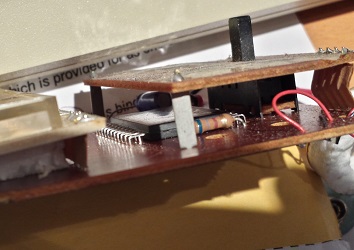
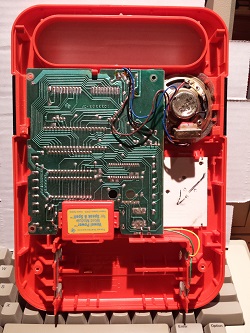
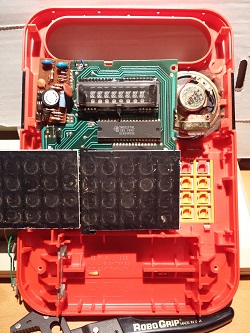
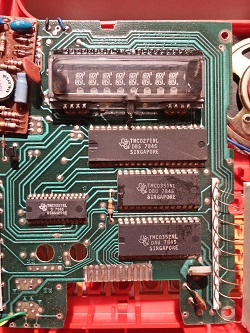
“how the playfield blips were switched between dim and high brightness”: I don’t know if it’s what was used here, but the standard solution to adjustable brightness on an LED controlled by a digital output is pulse width modulation with adjustable duty cycle. If the LED cycle between on and off, the apparent brightness will be proportional to the amount of time the LED is on relative to the cycle period.
This also works with a multiplexed LED matrix display too. By deliberately not refreshing a particular LED on every refresh cycle, you can make it appear dimmer than the others. Of course, this also requires a faster refresh rate, otherwise you’ll be able to see the reality that it’s just blinking differently than the other LEDs.
Just a little clarification about the Speak’n’Spell: it was sold as “Grillo parlante” in Italy (distributed by Clementoni).
“Grillo parlante” (“talking cricket”) was one of the characters in the “Pinocchio” novel from the italian writer Collodi (see: http://en.wikipedia.org/wiki/The_Talking_Cricket).
I own a Grillo Parlante and for sure it speaks italian! 🙂
Honestly I can’t say if in Spain and South America was called “Grillo Parlante” (I doubt); as far as I know, nobody seems to know anything about it in Brazil.
In Mattel Football 1 the brighter LED was implemented by varying the duty cycle for that segment. The entire playfield display consisted of a multiplexed array of LED segments. Display output drivers on the B6100 chip were divided into strobe and segment drivers. The strobe outputs drove each group of segments sequentially. The segment outputs selected individual segments for display.